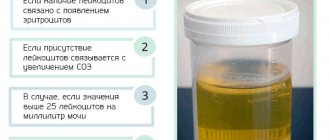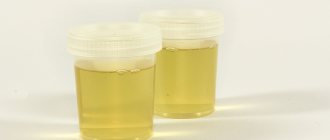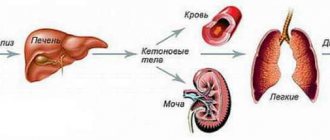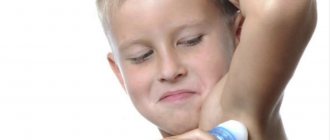Causes and types of salts in urine
Salt in urine in a child: types and possible diseases
Often, parents are not told anything by the result of a child’s urine test containing a high salt content. The analysis should definitely be repeated to determine whether the salt content is constantly elevated. If this is an isolated case, it does not indicate any disease. However, if sediment appears constantly in the urine and there is a lot of it, you should undergo further examination of the gastrointestinal tract and urinary system.
Salt in the urine of a child is normal as long as the amount of salt does not exceed the permissible value. Urine contains many salts that precipitate in a certain environment: acidic or alkaline.
Typically, such problems with high salt content occur in preschoolers, which is associated with nutrition and the inability of the kidneys to work at full capacity.
There are several types of salts that can be found in a child’s urine:
- Oxalates. They can be found most often in a child’s urine. This can be caused by diseases of the urinary system, various inflammations, stomach ulcers, poisoning, as well as an excess of vitamin C in the child’s diet (citrus fruits, chocolate, sorrel, etc.) and a lack of other vitamins (E, A, group B).
- Urats. Externally, these salts look like a dark red sediment in the urine. In a child, the reason for the increased content of urates in the urine is poor diet, namely a large amount of meat, fish products, legumes, chocolate, as well as a lack of fluid in the body. Some blood diseases may also be the cause.
- Phosphates. They can be found in urine even in the absence of disease, but for example, during overeating. In this case, the pH level is disrupted, the acidity of the urine decreases, and the amount of phosphates increases. The amount of these salts is also affected by the diet: an abundance of foods rich in phosphorus, such as fish, buckwheat, and abuse of alkaline mineral water.
- Salts of hippuric acid. The abundance of these salts, as a rule, is an alarming sign indicating impaired liver function, kidney stones, and diabetes mellitus. The reasons may also be more harmless, for example, excessive use of antipyretics or a large amount of plant food to the detriment of animal food.
Diagnosis and symptoms
Assignment for research and proper collection of material for analysis
Diagnosis is carried out in a standard way: the mother collects the child’s urine in a container and takes it to the laboratory for analysis. The result of the analysis is deciphered by the doctor. If the test shows a high salt content, the pediatrician will most likely ask you to retake it to ensure the accuracy of the laboratory test. Then, with further examination (blood tests, ultrasound, MRI, etc.), the doctor will prescribe treatment.
Collecting urine from a child who is already using the potty is quite simple. However, it is important that the child waits until the morning and does not go to the toilet, otherwise he may no longer want to go to the toilet in the morning. If a child sleeps in a diaper, there is no point in wringing it out. Such urine is unsuitable for examination. Modern diapers turn it into a gel, changing the composition.
A small child who is not even sitting yet can be given a urine collector.
This is a small bag with special Velcro. It should be placed closer to the morning, since urine is stored for no more than an hour or two. It is advisable to immediately deliver it to the laboratory. Since urine is a quickly perishable material that tends to ferment, laboratory technicians conduct an examination in the morning of the day of delivery and the result is ready on that or the next day.
Useful video for parents - Salt in the urine of a child.
Read: What are they talking about and why are elevated white blood cells in the urine of pregnant women dangerous?
Elevated levels of salts in the urine can be detected during a standard routine examination or during examination of a completely different disease. However, in some cases, mothers themselves become worried and ask for an appointment for a urine test.
In this case, parents may be concerned about the following symptoms:
- The child complains of pain in the abdomen and lower back. The pain can be severe, paroxysmal, intensifying when walking, but subsiding over time.
- The mother noticed blood in the child’s urine, or the color of the urine had changed. Normally, urine is light or deep yellow in color. If your urine turns dark like beer, you should get tested.
- The child has stool upset, vomiting, and complains of a burning sensation when urinating. Appetite and sleep worsen. Sometimes you may notice that the child runs to the toilet or potty too often, while the urine portions are small or absent altogether.
Types of salts
During the examination, an increased content of crystals of the following salts can be detected in a child’s urine:
- oxalates;
- phosphates;
- urates;
- sulfates;
- salts of hippuric acid.
Of all the above substances, analysis most often shows an elevated level of oxalates.
Not everyone knows, but infants may also experience an increased amount of salts in the urine.
This usually happens when the child’s mother has a malnutrition. Excessive consumption of salted fish, strong tea and coffee, chocolate, mushrooms, citrus fruits, as well as drugs that contain ascorbic acid - all this can cause pathological changes in the composition of the baby’s urine.
In more rare cases, an increase in salt concentration is observed in the presence of kidney pathologies or inflammatory processes in the bladder of an infant.
Children with all types of nephropathies are monitored in the clinic by a pediatrician and a nephrologist. Hospitalization in a hospital is required only in case of complications - pyelonephritis, urinary tract infection, stone formation, or in case of a detailed examination to determine the cause and clarify the diagnosis.
Children with dysmetabolic nephropathy, depending on the condition, are assigned health groups from IIb to IV. Such babies are examined by a pediatrician monthly during the first year of observation, then once every three months, and by a nephrologist - once every six months.
Children take the necessary tests and undergo examinations - urine analysis is monitored monthly. Moreover, it is desirable to determine the nature of the urinary sediment and the size of salt crystals. A Zimnitsky test is performed, which gives an idea of the concentrating ability of the kidneys, and an ultrasound of the kidneys and bladder is performed. If necessary, the doctor may prescribe an X-ray examination using contrast agents.
Sometimes the doctor asks parents to monitor urine pH at home with special test strips and record the results. These data make it possible to adjust the diet and dosage of medications.
Dispensary observation is carried out before the child is transferred to an adult clinic.
Drug treatment
Salt in the urine of a child: comprehensive treatment of pathology
Only a pediatrician should prescribe treatment. It includes a diet and certain medications, the selection of which depends on the type of salts. However, treatment should only be comprehensive.
The most important components of treatment are diet, sufficient physical activity and regular use of prescribed medications:
- If a child has a large amount of oxalates in the urine, he is prescribed a vitamin complex and pyridoxine (a type of vitamin B6), as well as magnesium oxide. Pyridoxine is available both in solution for injection and in tablets. Children are given the drug after meals, 2 mg per day. The dosage may vary depending on the age, weight of the child and the severity of his condition.
- If there are problems with the intestines (the medicine will not be absorbed) or vomiting is observed, pyridoxine can be administered intramuscularly or intravenously. The course can last up to 20 injections. After 2-3 months it is repeated if necessary. Such injections are given to a child with caution, as similar effects are possible: allergic reactions and convulsions with rapid administration of the drug.
- If there is a large amount of phosphate in the urine, drugs are prescribed that reduce the secretion of gastric juice. An abundance of phosphate salts can lead to the formation of stones. Such stones usually do not require surgical intervention. They can be dissolved or removed by other means. It is important to follow a diet during this treatment, since it is nutrition that leads to the formation of stones. Usually limited to diet correction and taking herbal medications.
- If urates are found in large quantities in the urine, the child’s diet should also be changed. It is also important to determine the cause. Sometimes the increased content of urates in the urine is caused by intestinal dysfunction, dysbacteriosis, and worms in the intestines. All these conditions must be eliminated. If there is a large amount of urate, a drug called Blemaren is often prescribed. It comes in the form of effervescent, soluble tablets and is convenient to give to children. The effect of this drug is to reduce the acidity of urine. However, this drug is contraindicated in phosphate stones.
Crystalluria
The urine-forming organ is the renal apparatus. The nephrons (the structural and functional components of the kidney unit) are responsible for the filtration of blood plasma, and the tubular system is responsible for the reabsorption of nutrients. Adjacent organs of the urinary system ensure the accumulation and evacuation of urine.
Salts do not dissolve, but crystallize and settle in the urine-forming and urinary organs - kidneys, bladder (less often - in the ureters). Failure to promptly identify and treat salt deposits leads to a gradual increase in the size of the crystals.
Ultimately, concretions (stones) are formed from them, and the child is diagnosed with one of the types of urolithiasis (KD): nephrolithiasis (renal stone disease), in adjacent organs - urolithiasis (cystolithiasis - in the bladder, ureterolithiasis - in the ureter).
Crystals are classified according to their chemical composition:
- calcium phosphates (phosphate salts or phosphates);
- uric acid salts (urates or urates);
- salts of oxalic acid (oxalates);
- calcium salts of carbonic acid (carbonates);
- amino acids cystine (cystine crystals).
A one-time insignificant presence of crystals, indicated in the OAM form as the norm of salts “”, is not a pathology.
Salt in urine: proper nutrition
Diet for high levels of salt in the urine of a child
Treatment of salts in urine and stones with folk remedies can only be justified if these remedies are prescribed by a doctor. Self-medication is not recommended.
Often folk remedies are combined with a special diet, which allows the child’s body to quickly cope with accumulations of salts.
- For example, oxalates are treated with various vegetable and berry decoctions. It is recommended to drink as much as possible. Children enjoy drinking compotes and fruit drinks. It is also recommended to drink decoctions of mint, dill, strawberry leaves, parsley, freshly squeezed carrot juice, and rowan juice. It is recommended to eat more foods that are rich in vitamin B6. These products include liver, bran, beans, and pumpkin seeds. You should avoid greens, onions, beets, cabbage, meat broths, and chocolate.
- Treatment of phosphates in the urine is carried out almost exclusively by adjusting the diet. You can drink various fruit and berry drinks, jelly, compotes, boiled and stewed vegetables, rice (preferably brown, brown), broths, light soups. Foods such as fatty dairy products, soda, fatty meat and fish, processed cheese, canned food, and chocolate should be excluded from the child’s diet.
- Uraturia in children is often treated with the herb pol-pal. It is intended for the treatment of kidney diseases and has a diuretic effect. It is easy to find in pharmacies. The diet is not too strict. There is no need to deprive your child of sweets, but you need to limit or completely eliminate the consumption of chocolate and cocoa. You can eat fruits, nuts, dairy and fermented milk products, eggs (boiled and in small quantities or in the form of an omelet), vegetables (potatoes, eggplants, peppers, cucumbers, pumpkin), dried fruits, apples, grapes, oranges, tangerines, pears, pasta and rye bread.
It is imperative to exclude from the child’s diet those foods that provoke changes in urine. These include fatty meats and fish, carbonated drinks, canned food, and broths. It is necessary to limit the consumption of baked goods, onions, legumes and greens. The child also needs to drink more fluids, preferably clean, unboiled water. The amount of fluid depends on the age and weight of the child. It is advisable to drink at least 1.5 liters per day.









